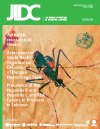Correlation of Trichomonas vaginalis to bacterial vaginosis: a laboratory-based study
DOI:
https://doi.org/10.3855/jidc.434Keywords:
Vaginitis, Trichomonas vaginalis, Gardenrella vaginalisAbstract
Background: This study aimed to define the occurrence of different organisms causing vulvovaginitis; to evaluate different laboratory methods used for diagnosis of Trichomonas vaginalis (T. vaginalis); and to evaluate the direct score system and clue cell method compared with culture for diagnosis of bacterial and T. vaginalis vaginosis.
Methodology: Clinical and laboratory evaluations were performed for 110 patients. Laboratory methods used for bacteriological diagnosis were direct Gram staining for clue cells and scoring by Nugent score system and bacterial culture. T. vaginalis was identified by wet mount microscopic examination, culture, direct Gram, Giemsa staining and acridine orange (AO).
Results: The Nugent score method revealed that the sensitivity and specificity for diagnosis of vaginal discharge by direct rapid microscopic methods were 30% and 80% and for clue cells sensitivity and specificity were 37% and 75% respectively for diagnosis of bacterial vaginosis compared to culture. For diagnosis of T. vaginalis, the Nugent score method revealed that the sensitivity and specificity were 60% and 90% respectively, and for clue cells 75% and 80% respectively. For microcopic methods used for T. vaginalis only, the Gram stain and Giemsa stain sensitivities were poor (15.2% and 48.5%, respectively). Wet mount showed reasonable sensitivity of 75.8%. Acridine orange sensitivity was 93.9% and specificity was 97.5%,
Conclusion: Prevalent pathogens associated with vaginitis were (Gardnerella vaginalis) G. vaginalis, T. vaginalis and Mycoplasma hominis (M. hominis). Wet mount microscopic examination, acridine orange, and high Nugent score were found as rapid and sensitive methods for diagnosis of T. vaginalis.
Downloads
Published
How to Cite
Issue
Section
License
Authors who publish with this journal agree to the following terms:
- Authors retain copyright and grant the journal right of first publication with the work simultaneously licensed under a Creative Commons Attribution License that allows others to share the work with an acknowledgement of the work's authorship and initial publication in this journal.
- Authors are able to enter into separate, additional contractual arrangements for the non-exclusive distribution of the journal's published version of the work (e.g., post it to an institutional repository or publish it in a book), with an acknowledgement of its initial publication in this journal.
- Authors are permitted and encouraged to post their work online (e.g., in institutional repositories or on their website) prior to and during the submission process, as it can lead to productive exchanges, as well as earlier and greater citation of published work (See The Effect of Open Access).








